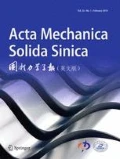Abstract
In this study, a size-dependent composite laminated skew Mindlin plate model is proposed based on a new modified couple stress theory. This plate model can be viewed as a simplified couple stress theory in engineering mechanics. Governing equations and related boundary conditions are derived based on the principle of minimum potential energy. The Rayleigh—Ritz method is employed to obtain the numerical solutions of the center deflections of simply supported plates with different ply orientations. Numerical results show that the normalized center deflections obtained by the proposed model are always smaller than those obtained by the classical one, i.e. the present model can capture the scale effects of microstructures. Moreover, a phenomenon reveals that the ply orientation would make a significant influence on the magnitude of scale effects of composite laminated plates at micro scale. Additionally, the present model of thick skew plate can be degenerated to the model of Kirchhoff plate based on the modified couple stress theory by adopting the assumptions in Bernoulli—Euler beam and material isotropy.
Similar content being viewed by others
References
M.A. Haque, M.T.A Saif, Strain gradient effect in nanoscale thin films, Acta Mater. 51 (11) (2003) 3053–3061.
Z.C. Leseman, T.J Mackin, Indentation testing of axisymmetric freestanding nanofilms using a MEMS load cell, Sens. Actuators, A 134 (1) (2007) 264–270.
M.A. Haque, M.T.A Saif, Microscale materials testing using MEMS actuators, J. Microelectromech. Syst. 10 (1) (2001) 146–152.
W.M.A.J. Andrew, Role of material microstructure in plate stiffness with relevance to microcantilever sensors, J. Micromech. Microeng. 15 (5) (2005) 1060.
J.S. Stölken, A.G Evans, A microbend test method for measuring the plasticity length scale, Acta Mater. 46 (14) (1998) 5109–5115.
Q Ma, D.R Clarke, Size dependent hardness of silver single crystals, J. Mater. Res. 10 (04) (1995) 853–863.
N.A. Fleck, G.M. Muller, M.F. Ashby, J.W Hutchinson, Strain gradient plasticity: theory and experiment, Acta Metall. Mater. 42 (2) (1994) 475–487.
D.C.C. Lam, F. Yang, A.C.M. Chong, J. Wang, P Tong, Experiments and theory in strain gradient elasticity, J. Mech. Phys. Solids 51 (8) (2003) 1477–1508.
M. Kouzeli, A Mortensen, Size dependent strengthening in particle reinforced aluminium, Acta Mater. 50 (1) (2002) 39–51.
N.A. Fleck, J.W Hutchinson, Strain gradient plasticity, Adv. Appl. Mech. 33 (1997) 295–361.
E. Cosserat, F Cosserat, Théorie Des Corps Déformables, Paris, 1909.
Toupin R.A. Elastic materials with couple-stresses. 1962;11(1):385–414.
Mindlin R.D., Tiersten H.F. Effects of couple-stresses in linear elasticity. 1962;11(1):415–448.
W. Koiter, Couple-stresses in the theory of elasticity[J], Dictionary Geotechnical Engineering/wörterbuch Geotechnik 67 (1964) 1385.
J. Altenbach, H. Altenbach, V.A. Eremeyev, On generalized Cosserat-type theories of plates and shells: a short review and bibliography, Arch. Appl. Mech. 80 (1) (2010) 73–92.
C. Cosserat, F. Cosserat, Théorie des corps déformables, Nature 81 (2072) (1909) 67.
Neuber H. On the General Solution of Linear-Elastic Problems in Isotropic and Anisotropic Cosserat Continua. 1966, pp. 153–158.
R.D. Mindlin, Influence of couple-stresses on stress concentrations, Exp. Mech. 3 (1) (1963) 1–7.
F. Yang, A.C.M Chong, D.C.C Lam, P Tong, Couple stress based strain gradient theory for elasticity, Int. J. Solids Struct. 39 (10) (2002) 2731–2743.
S.K. Park, X Gao, Bernoulli–Euler beam model based on a modified couple stress theory, J. Micromech. Microeng. 16 (11) (2006) 2355.
H.M. Ma, X.L. Gao, J.N Reddy, A microstructure-dependent Timoshenko beam model based on a modified couple stress theory, J. Mech. Phys. Solids 56 (12) (2008) 3379–3391.
G.C. Tsiatas, A new Kirchhoff plate model based on a modified couple stress theory, Int. J. Solids Struct. 46 (13) (2009) 2757–2764.
L. Yin, Q. Qian, L. Wang, W Xia, Vibration analysis of microscale plates based on modified couple stress theory, Acta Mech. Solida Sin. 23 (5) (2010) 386–393.
Chen W., Li X. A new modified couple stress theory for anisotropic elasticity and microscale laminated Kirchhoff plate model. 2014;84(3):323–341.
W. Chen, J Si, A model of composite laminated beam based on the global–local theory and new modified couple-stress theory, Compos. Struct. 103 (0) (2013) 99–107.
C. Wanji, W. Chen, K.Y Sze, A model of composite laminated Reddy beam based on a modified couple-stress theory, Compos. Struct. 94 (8) (2012) 2599–2609.
W. Chen, M Xu, L Li, A model of composite laminated Reddy plate based on new modified couple stress theory, Compos. Struct. 94 (7) (2012) 2143–2156.
W. Chen, L. Li, M Xu, A modified couple stress model for bending analysis of composite laminated beams with first order shear deformation, Compos. Struct. 93 (11) (2011) 2723–2732.
J. Bin, C Wanji, A new analytical solution of pure bending beam in couple stress elasto-plasticity: theory and applications, Int. J. Solids Struct. 47 (6) (2010) 779–785.
C.M.C. Roque, D.S. Fidalgo, A.J.M. Ferreira, J.N Reddy, A study of a microstructure-dependent composite laminated Timoshenko beam using a modified couple stress theory and a meshless method, Compos. Struct. 96 (2013) 532–537.
M. Mohammadabadi, A.R. Daneshmehr, M Homayounfard, Size-dependent thermal buckling analysis of micro composite laminated beams using modified couple stress theory, Int. J. Eng. Sci. 92 (2015) 47–62.
M. Mohammad Abadi, A.R Daneshmehr, An investigation of modified couple stress theory in buckling analysis of micro composite laminated Euler–Bernoulli and Timoshenko beams, Int. J. Eng. Sci. 75 (2014) 40–53.
J.N. Reddy, Mechanics of Laminated Composite plates: Theory and Analysis, CRC Press, Boca Raton, 1997.
J.N. Reddy, Mechanics of Laminated Composite Plates and Shells: Theory and Analysis, CRC Press, 2004.
Author information
Authors and Affiliations
Corresponding author
Rights and permissions
About this article
Cite this article
He, D., Yang, W. & Chen, W. A size-dependent composite laminated skew plate model based on a new modified couple stress theory. Acta Mech. Solida Sin. 30, 75–86 (2017). https://doi.org/10.1016/j.camss.2016.12.001
Received:
Revised:
Accepted:
Published:
Issue Date:
DOI: https://doi.org/10.1016/j.camss.2016.12.001


